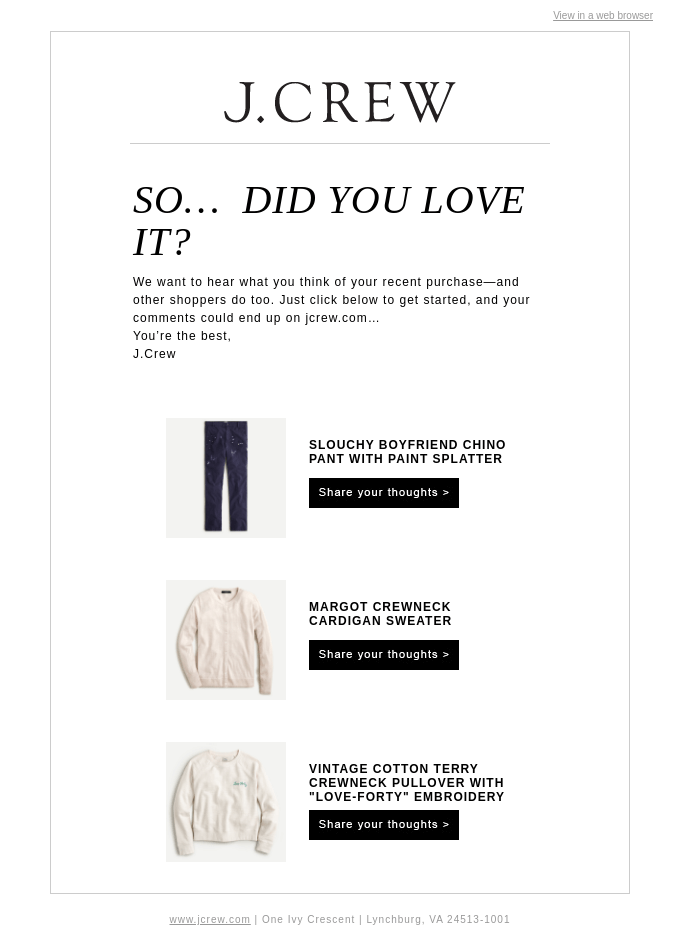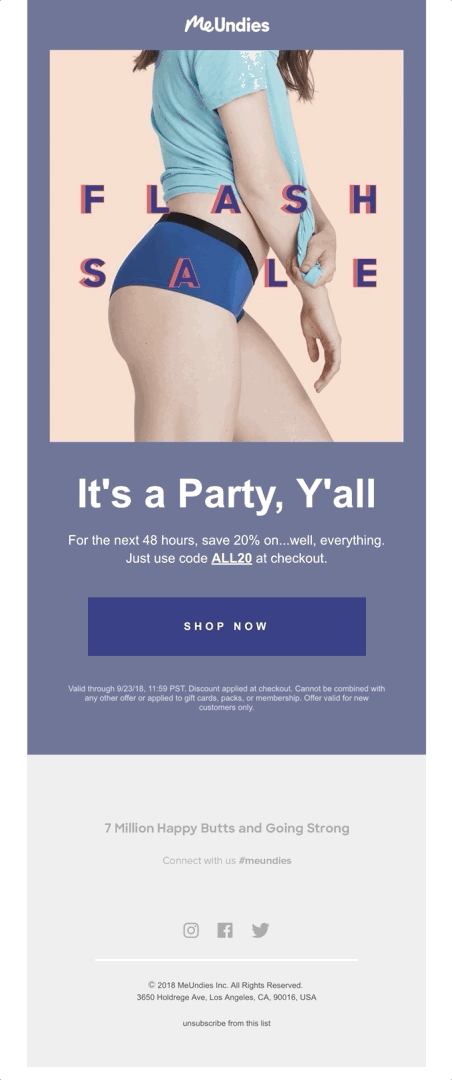In the bustling world of e-commerce, there’s no shortage of ways to reach your customers. Social media, search engine optimization, paid ads, influencer partnerships—the list goes on and on.
But there’s one marketing strategy that’s been a consistent powerhouse across all industries. Know what it is? Well, it’s none other than email marketing.
However, with about 361.6 billion emails sent and received every single day this year alone, it’s easy to wonder: how do you make your email stand out from the rest? If you’re asking the same question, then you’re in the right place.
In this guide, we’ll explore the types of email marketing campaigns that work best for e-commerce businesses and share actionable tips to help you craft emails that drive real results.
What Is E-commerce Email Marketing?
E-commerce email marketing is a strategy that online businesses use to connect with their customers through targeted emails. It involves sending messages to promote products, offer discounts, and share updates like order status or abandoned cart reminders.
These emails can be one-time campaigns or automated triggered by customer actions such as browning behavior or past purchases. The goal of email marketing is to boost engagement, recover lost sales, and increase overall revenue.
Why Email Marketing is Important For Your E-commerce Business?
Building Lasting Relationships with Customers
Email marketing allows you to nurture relationships with both new and existing customers. By sending personalized messages, you can keep your brand top-of-mind and ultimately encourage repeat purchases.
Also, research shows that 59% of consumers say that marketing emails influence their buying decisions. This means that a well-crafted email can not only inform but also convince your customers to choose your products over your competitors.
Cost Effective and High ROI
One of the most compelling reasons to invest in email marketing for e-commerce is that it’s one of the most affordable channels available. Compared to paid ads, it requires minimal financial investment, especially when factoring in the return on investment (ROI).
Did you know that, according to Litmus, businesses can expect an average return of $36 for every dollar spent on email marketing? This shows how effective email campaigns can be in driving sales without breaking the bank.
Targeted Messaging for Better Engagement
One of the standout features of email marketing is its ability to deliver direct, personalized messages. By segmenting your email list based on customer behavior and preferences, you can tailor your communication to meet the individual needs of your customers.
For instance, if a customer frequently purchases fitness gear, then you can send them targeted promotions related to new arrivals in that category. Even statistics back this point up, as 73% of consumers expect brands to understand their needs and tailor messages accordingly.
Email Marketing Types Used by E-commerce Merchants
E-commerce merchants use various types of email marketing to engage their customers, drive sales, and enhance the overall shopping experience.
While we will discuss the different types of email campaigns in the section below, here are three primary categories under which the various campaigns fall.
Transactional Emails
Transactional emails are automated messages sent in response to specific actions taken by customers on an e-commerce site, such as making a purchase or resetting a password.
These emails contain information relevant to the transaction and are typically sent to individual recipients. Some common examples of these types of emails include:
-
- Order confirmations.
-
- Shipping notifications.
-
- Account creation emails.
-
- Password reset emails.
Promotional Emails
Promotional emails are messages designed to drive sales by promoting products, services, or special offers. Some common types of promotional emails include:
-
- Discounts and offers
-
- Product launches.
-
- Seasonal campaigns.
-
- Flash sales.
However, it’s important not to send promotional emails too frequently, as this can lead to high unsubscribe rates. A good rule of thumb is to limit these emails to once a week.
Lifecycle Emails
Lifecycle emails are triggered based on a customer’s behavior or stage in their relationship with the brand. These emails aim to nurture leads, re-engage inactive customers, and build long-term loyalty. Examples include:
-
- Welcome emails.
-
- Birthday or anniversary messages.
-
- Abandonment cart emails.
-
- Post-purchase follow-ups.
These emails help create a personalized experience for each customer based on their unique interactions with the brand.
15 Email Marketing Campaigns (With Examples) to Grow Your E-commerce Business
Whether you’re just getting started or looking to refresh your strategy, there’s a lot you can do to make emails that are fun, engaging, and effective! Here are 15 proven campaign types (with examples!) to get your creativity flowing.
1. Welcome Emails
You know how people always say, “First impressions matter”? Well, that couldn’t be truer when it comes to welcome emails! These emails are your first introduction to new subscribers, and it’s also your chance to set the tone for what they can expect from your brand. In fact, 74% of people expect to receive a welcome email when they sign up, which means they’re looking forward to hearing from you.
To create an engaging welcome email, take inspiration from Bubble, a skincare brand. Their welcome email offers a special discount, highlights some community fav products, and includes a proper CTA.
On top of that, the clean design and friendly language make it relatable and inviting, encouraging new subscribers to make their first purchase.
2. Upsell and Cross Sell Emails
Do you want to increase your average order value without having to acquire new customers? That’s exactly what upsell and cross-sell emails are designed to do – they help you make the most of the customers you already have.
Upsell emails encourage customers to purchase a higher-end version of a product they’ve shown interest in or just bought. For example, if someone bought a basic version of your product, you could suggest a more advanced model or an extended warranty. On average, upselling increases revenue by 10-30% when done effectively.
Here’s a good example from the Frontman.
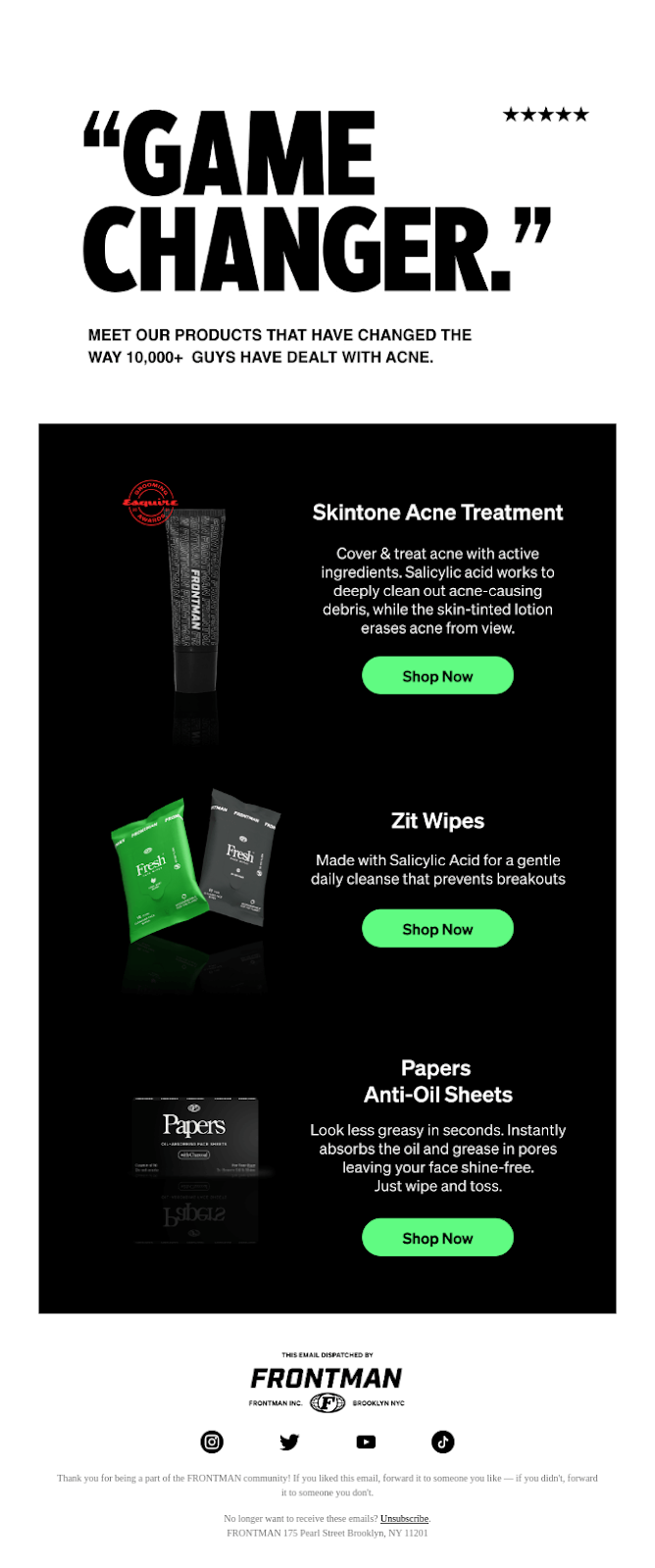
On the other hand, cross-sell emails recommend complementary products that pair well with a customer’s recent purchase. Ever noticed how Amazon always suggests related items to go along with your purchase? That’s cross-selling in action.
Take this email by Crate And Barrel as an example.
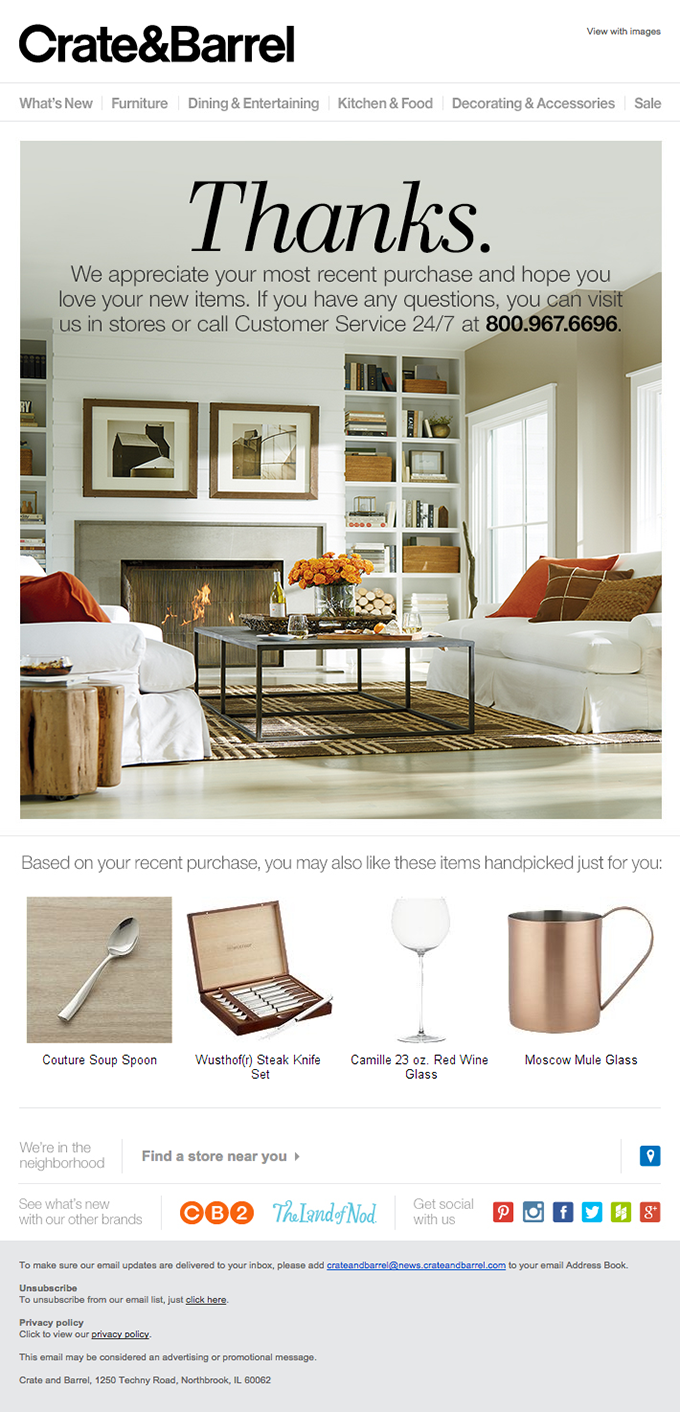
3. Restock or Back in Stock Emails
Scarcity is a powerful motivator, and when a product sells out, it often increases its appeal. So, if a customer has been eyeing an item that went out of stock, don’t let them forget about it.
Instead, when that item replenishes, sending them a “back in stock” email immediately can be the perfect nudge to bring them back to your store. Also, these emails tend to perform exceptionally well because you’re giving customers exactly what they were waiting for.
An excellent example of a restock email is this one by Sproos. The vibrant design uses bold colors like red and purple to highlight the return of its red shower bundles. High-quality images and a clear “Shop Now!” CTA creates urgency, making it easy for customers to act quickly.
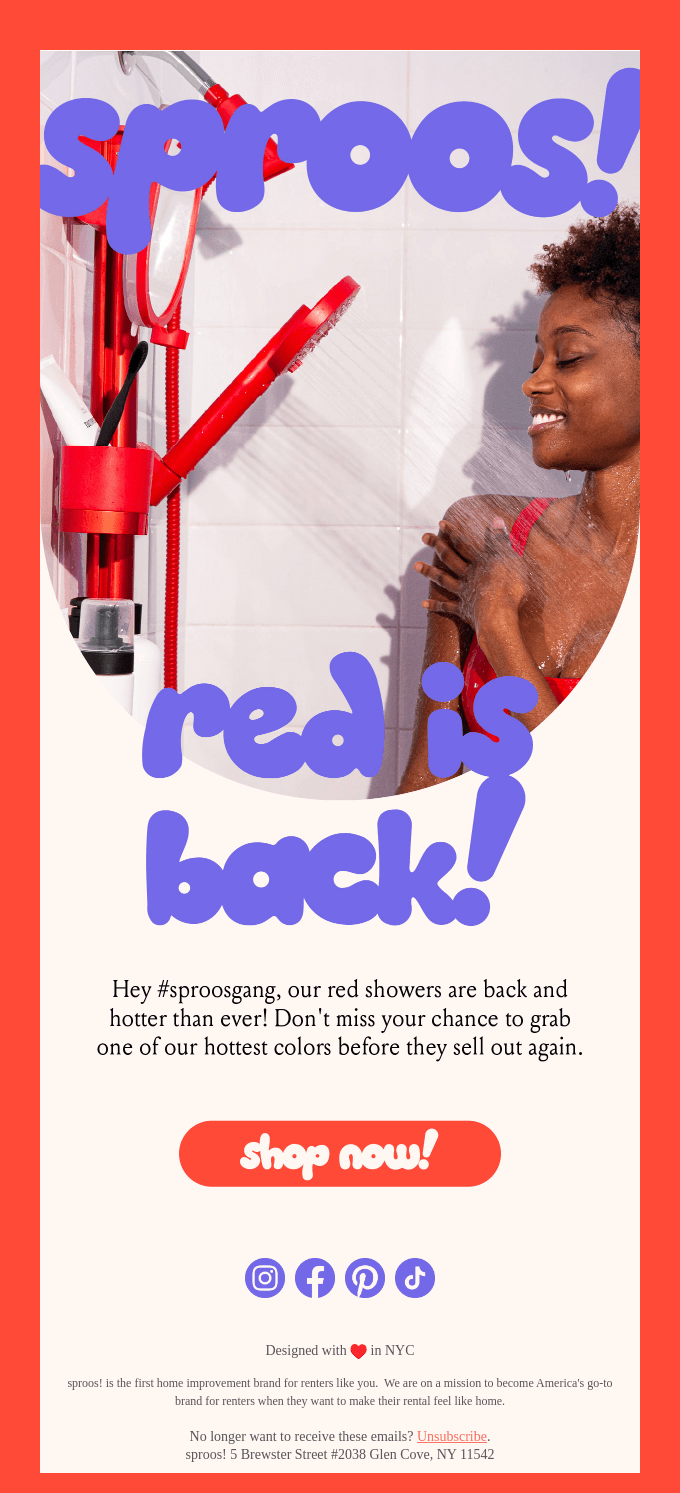
4. Review or Feedback Emails
When it comes to online shopping, customer reviews are gold. In fact, 89% of consumers worldwide make an effort to read reviews before making a purchase.
Also, for first-time buyers, reviews are often the deciding factor. And that’s why sending a review or feedback request email is essential for your e-commerce business.
Typically, these emails are sent a few days after delivery, giving customers enough time to use the product and share their thoughts. You can ask them to rate various aspects like the quality, fit, or overall satisfaction.
5. Abandoned Cart Emails
If there’s one email strategy that can truly make a difference in your bottom line, it’s the abandoned cart email. Cart abandonment is an issue every e-commerce business faces – on average, 70.19% of online shopping carts are abandoned, according to a Baymard Institute study. That means roughly 7 out of 10 potential sales are lost right at the finish line!
But here’s the good news: abandoned cart emails are like a lifeline, pulling those lost customers back in. In fact, studies show that abandoned cart emails can recover 10-15% of lost sales. Isn’t that amazing?
This email by Fabletics is the perfect example of how an abandoned cart email should be. Have a look.

6. Browse Abandonment Emails
Similar to abandoned cart emails, browse abandonment emails target customers who showed interest in a product but left before adding it to their cart. These emails are triggered when someone browses your site, visits a product page, and then leaves without taking further action.
Though it happens earlier in the sales funnel, it’s still a strong indicator of purchase intent. Also, these emails are armed with a conversion rate 1126% higher than promotional campaigns, which makes them a powerful tool for re-engagement.
Take this email by Pulp & Press as an example. This email is perfect as it’s simple and straightforward with a compelling subject line (We noticed you checking us out… 👀). Plus, the “Earn Rewards” incentive in the end is like the cherry on top.

7. Birthday or Anniversary Emails
Who doesn’t love a birthday surprise? Birthday and anniversary emails are a powerful way to boost engagement while making your customers feel special.
According to Experian, these emails, triggered by a customer’s or the brand’s birthday or the anniversary of their signup, can generate 481% more transactions, 179% more clicks, and 342% more revenue compared to standard marketing emails.
To maximize impact, you can include a thoughtful message along with a special discount, exclusive offer, or free gift. This small gesture shows that you value your customers beyond just transactions. Also, it’s best to automate these emails to be sent a few days before the special day, giving them time to browse and shop.

8. Product Launch Email
Just launched a new product? Exciting times! A product launch email is your chance to announce this fresh addition to your lineup and generate buzz among your audience. It’s also a strategic way to drive traffic to your sales page and encourage purchases.
To craft the perfect product launch email, use engaging subject lines and captivating visuals and highlight its main features. Also, don’t forget to create a sense of exclusivity – consider offering early access or a special discount for your email subscribers. Building anticipation in the weeks leading up to the launch can also be effective.
For inspiration, take a look at this email by Swoon.

9. Re-Engagement Emails
It’s only natural that, over time, some of your customers might lose interest or stop engaging with your emails. But that’s where re-engagement emails come in handy.
These emails are designed to win back the attention of inactive customers, and they work surprisingly well, as 45% of recipients engage with future emails after receiving a re-engagement message.
Here’s an example of a retention email by Glow Recipe.
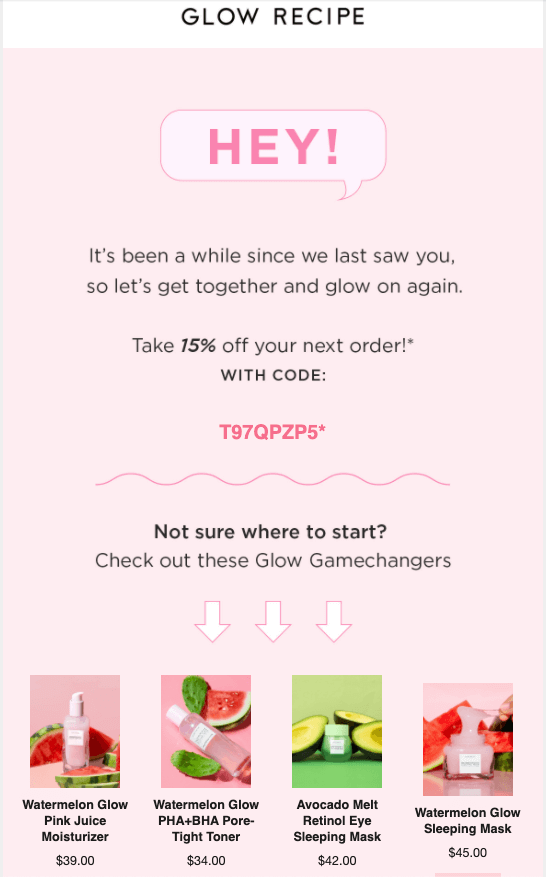
The goal is simple: just remind them why they loved your brand in the first place. And for that, you don’t need anything over the top – sometimes a “We Miss You” discount or a quick reminder is enough. Ask if they’re still interested in your emails or offer a special promotion to bring them back.
10. Newsletter Emails
Want to keep your audience engaged and informed? A newsletter is the perfect way to become a trusted resource for your subscribers. Whether it’s sharing helpful tips, industry updates, or behind-the-scenes insights about your brand, newsletters build strong relationships over time.
Consider this: 81% of B2B marketers use newsletters as their top content marketing tool. Why? Because they nurture trust without the hard sell.
For instance, Huckberry, a men’s lifestyle retailer, sends almost all its emails in the form of a newsletter. And it’s one the fastest-growing e-commerce brands out there. Take a look at one of its emails.

You can send newsletters weekly, biweekly, or monthly – whatever suits your business. Just make sure that you focus on providing real value, mixing in product highlights or exclusive deals to keep things interesting.
11. Shipping Email
Are you aware that, on average, most transactional emails have an open rate of 80-85%? This figure clearly shows that shipping emails are something you just cannot ignore!
So, while sending a shipping email isn’t strictly necessary, it creates a great customer experience and shows that you care about timely delivery. More importantly, it reassures customers that their order is on the way.
But why stop at just delivery info? You can take it further by adding a little extra value. For instance, you can include a “while you wait” product recommendation or offer a discount for their next purchase. This keeps your brand top of mind and encourages repeat business.

12. Thank You Emails
When was the last time you genuinely thanked your customers? It’s easy to overlook, but a heartfelt “thank you” can leave a lasting impression. More than just politeness, expressing gratitude makes customers feel valued and strengthens your relationship with them.
Also, customers who feel valued are much more likely to return, and in a world full of choices, that connection is priceless.
Here are a few things you can thank your customers for:
-
- Choosing to shop with you
-
- Recommending your brand to others
-
- Leaving a review or feedback
-
- Engaging with your content
-
- Being part of your journey
Take this post-purchase thank you email by Homes Alive as an example.

13. Referral Emails
Curious how to grow your customer base without spending a fortune? Referral emails are your answer! By encouraging your loyal customers to share their love for your brand with friends and family, you can tap into a powerful lead generation source. In fact, statistics show that customers referred by friends are 4 times more likely to make a purchase.
To create a win-win situation, consider offering incentives to both the referrer and the new customer with enticing rewards, like discounts or freebies.
A great example of this is Bombas, which offers a free pair of socks for every successful referral, motivating customers to spread the word.
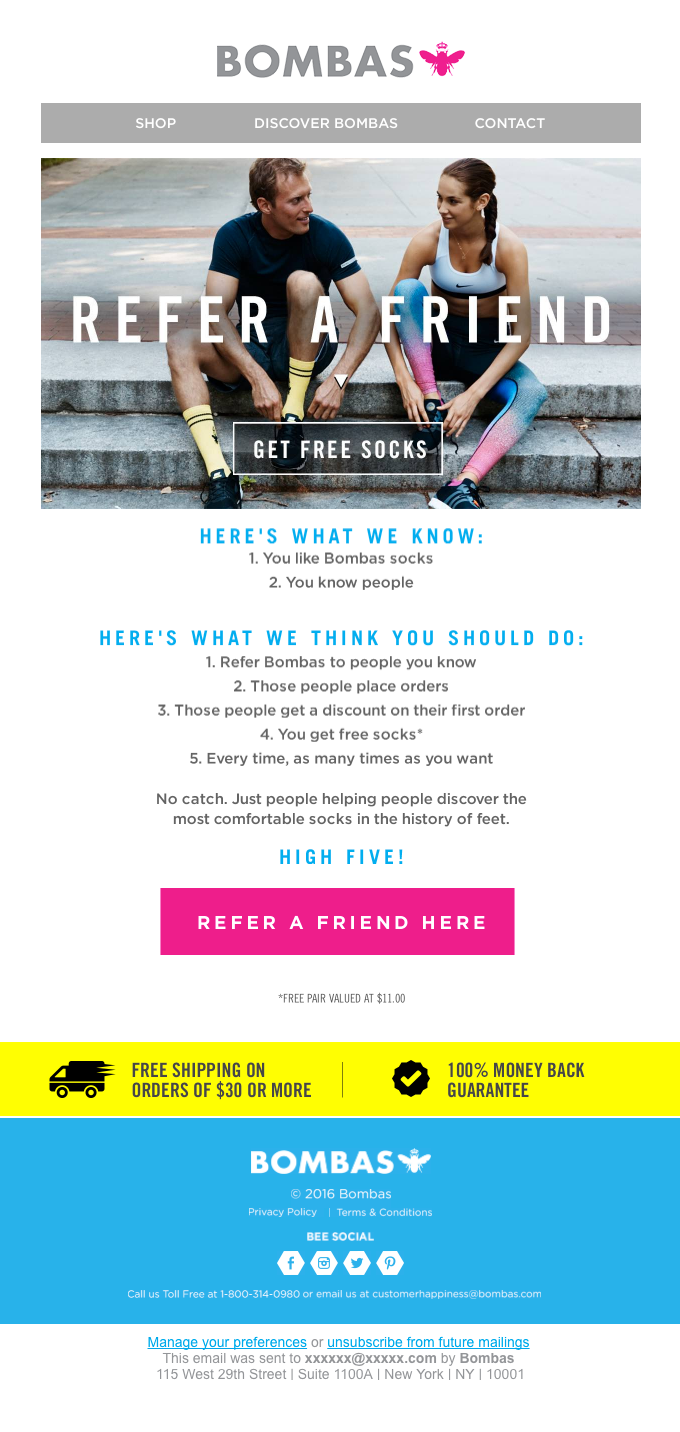
14. Seasonal or Holiday Emails
Seasonal or holiday-themed emails are fantastic for connecting with your audience during special times of the year. Think about major holidays like Valentine’s Day, Thanksgiving, Christmas, Easter, or even the Fourth of July. People are often in a buying mood around this time, making your emails more likely to catch their attention.
Consider segmenting your email list based on demographics or location to make your holiday messages even more relevant. This personalization can make your emails feel more special and less like just another promotion.
Also, don’t forget to create a sense of urgency with limited-time offers and exclusive deals. When customers see that they might miss out, they’re more likely to take action.

15. Sales Announcements Emails
Got a sale? It’s time to shout it from the rooftop! Sales announcements are essential for driving traffic during key shopping events such as Black Friday or flash sales, and they can make a significant impact on your bottom line.
But what makes a sales email truly effective? Well, it’s all about creating urgency!
To do that, you can use catchy subject lines like “Flash Sale: 24 Hours Only!” or “Limited Stock: Grab Your Favorites at 50% Off!” to grab attention and entice your subscribers to act quickly.
A good example of these kinds of emails is this one from MeUndies.
10 Best Strategies for E-commerce Email Marketing
Simply setting up different types of email just won’t cut it. You need more than that. So, below are 10 key e-commerce email marketing strategies that can take your emails from “meh” to “amazing” in no time.
1. Use a Reliable Email Service Provider
Let’s kick things off with the backbone of your email marketing: choosing a reliable email service provider (ESP). This decision is extremely important as a solid ESP will not only help you manage your lists but also offer essential tools for automation, segmentation, analytics, and design.
Now, there are so many options out there that it can be overwhelming to find the “perfect“ one, but don’t stress too much! The thing that you need to keep in mind is to select a well-reviewed ESP that meets your immediate needs. Look for features like user-friendly drag and drop editors, pre designed email templates, and competitive pricing.
Some popular platforms that are highly recommended and can help you implement the strategies we talked about earlier include Mailchimp, Klaviyo, and Campaign Monitor. Also, remember that you’re not locked in forever – switching providers is always an option down the line if you need change.
2. Build Your Email List
We know that it’s tempting just to buy email lists, but we strongly recommend you NEVER ever do it. Because if you do that, you’ll most probably end up in spam folders and those people won’t be interested in what you’re selling.
It’s important to understand that the customers who willingly subscribe to your email will more likely engage with your campaigns and increase open rates, ultimately boosting conversions.
Here are some effective tactics that you can use to build your email list:
-
- Use exit-intent pop-ups on your website to capture visitors before they leave.
-
- Offer incentives like discounts or free shipping to new subscribers.
-
- Make signing up fun with interactive elements like spin-to-win wheels for discounts.
-
- Create dedicated landing pages for specific promotions or products that encourage sign-ups.
-
- Promote your list on social media platforms to reach a broader audience.
3. Send the Right Emails at the Right Time
Timing is everything! Imagine sending out sale offers at 2 AM when people are fast asleep. They’ll probably miss it, or even if they see it, they’ll probably forget about it by morning. You want to hit their inbox when they’re most likely to open and engage with their mail.
For instance, according to a survey conducted by HubSpot, the best time to send marketing emails is between 9 AM to 12 PM or 12 PM to 3 PM. And the best days to send out emails are Tuesday, Monday, and Thursday.
However, there’s no fixed rule. The “best time” can vary depending on your audience and industry. So, the best way is to look at data to figure out when your audience is most likely to engage.
4. Personalize Your Messages
Let’s agree- we’re long past the days of generic “Dear customer” emails. Customers, especially the modern audience, crave personalization. In fact, 52% of customers are likely to switch brands when an email is not personalized. Crazy, right? But it makes sense – people want to feel seen, not like just another number in your database.
Our recommendation would be to start small, like using their first name in the subject line or body of the email. It may seem simple, but you’d be surprised to know that emails with personalized subject lines are 26% more likely to be opened.
But don’t stop there! Nowadays, shoppers are well aware that brands have access to their data, such as browsing history, previous purchases, etc. So, why not use that info to make your emails more relevant?
For example, if someone browsed your website and added a product to their cart but didn’t check out, you can send a friendly reminder featuring that specific product, maybe even throw in a discount to sweeten the deal.
5. Segment Your Audience
Above, we touched on the power of using customer data to personalize your emails, but you might be wondering – how can you make that happen? That’s where segmentation comes in!
Segmenting your audience means dividing your email lists into smaller, targeted groups based on specific criteria, like behavior, demographics, interests, or even the stage of the buying journey. For instance, a customer who just made their first purchase deserves a different message than a loyal shopper who’s been with you for years.
By using this email marketing strategy for e-commerce, you’ll be able to meet the unique needs of each segment. Also, it can significantly boost engagement and reduce the likelihood of unsubscribing. In fact, marketers who segment their lists see a staggering 760% increase in revenue!
6. Include a Clear Call to Action
Every email should have a purpose, and that purpose should be crystal clear. Whether you’re driving customers to browse a new collection or offering a limited-time discount, your call to action (CTA) needs to stand out and be easy to follow.
The simpler and more direct your CTA, the better. In fact, emails with a single, clear CTA can increase clicks by 371% and sales by 1617% compared to those cluttered with multiple options. Think about it – if you ask readers too many things, they’re more likely to get confused or not act at all.
Apart from that, keep your CTAs short, snappy, and action oriented. Use words like “Get Started” or “Claim Offer” – simple, direct phrases that inspire action. Also, personalize them when possible. HubSpot found that personalizing a CTA can boost performance by 202%.
7. Perform A/B Testing
Is your audience more likely to engage with an email with a personalized subject line or with one that includes an enticing discount? Well, you’ll never know until you test it.
A/B testing allows you to compare two variations of an email element so that you can pinpoint what resonates most with your audience. For example, you can test two different button colors (like red vs. yellow) to find out which drives more clicks.
Here are some common elements to consider testing:
-
- Subject lines
-
- Preview text
-
- Product imagery
-
- Layout and design
-
- Font size and color
-
- CTA button text and color
-
- Send day and time
-
- Discounts and offers
To run effective A/B tests, remember to only test one element at a time so you know exactly what’s making the difference. For instance, if you’re testing button colors, keep everything else the same.
8. Have a Responsive Email Design
Are you aware that 55% of emails are opened on mobile devices? So, if your emails aren’t optimized for mobile, you’re already missing out on a huge chunk of your audience.
To overcome this, the key is to have a responsive design that automatically adjusts to different screen sizes. Whether customers are reading the email on a smartphone, tablet, or desktop, the experience should feel seamless.
To make your emails responsive, here are some tips:
-
- Choose a responsive email template that adapts your content and visuals for all devices.
-
- Keep your emails clean and concise as short paragraphs, bullet points, and smaller image sizes makes reading easier on smaller screens.
-
- Optimize fonts to be easily readable (14 – 16 works well), and ensure CTA buttons are large and tappable.
These tips not only make your emails look better but also boosts engagement and ensures no one gets frustrated trying to navigate a clunky, non-responsive design.
9. Add High-Quality Visuals
Let’s face it – while a wall of text can be tedious to read, poorly designed or low-quality visuals can be even more frustrating. Whether you’re showcasing products or sharing videos, your images should be crisp and professional, no matter what device your customers are using.
However, one thing that you should watch out for is the file size. If your visuals are too heavy, they might load slowly or not show up at all, especially on slower networks. So, always optimize your images to balance quality and load speed.
And remember to add alt text for every image so your message still gets across even if the visuals don’t load. Also, emails with great visuals can boost click-through rates by 42%, so trust us, it’s worth the extra effort.
10. Track Your Results
How do you know if your email campaigns are actually working? Tracking your email marketing performance is the only way to find out. Without it, you’re basically flying blind, hoping for the best.
Some key metrics to keep an eye on include:
-
- Open rate
-
- Click-through rate (CTR)
-
- Conversion rate
-
- Bounce rate
-
- Unsubscribe rate
-
- Spam rate
-
- Email ROI
The average open rate for most industries falls between 15-25%, while a strong click-through rate is around 2.5%. If your numbers are lower, it’s time to tweak things—maybe your subject lines aren’t grabbing attention, or your calls to action need to be clearer.
Also, remember that consumer preferences change over time, so monitoring trends and tweaking based on performance is critical to maximizing your email marketing ROI. With consistent tracking, you can continuously refine your approach, driving more engagement and conversions.
Final Thoughts
You’ve made it to the heart of e-commerce email marketing!
From welcome emails to abandoned cart reminders, product launches, and personalized offers, these email marketing ideas for e-commerce are all you need to boost sales and connect with customers.
So, start here, tweak along the way, and watch your emails turn into serious revenue!


